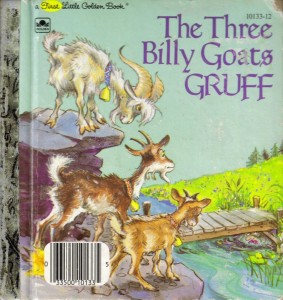When I was little, our family had an old tattered copy of the children’s classic, “The Three Billy Goats Gruff.” It’s an old Norwegian folk tale about three goats trying to cross a bridge under which lived a hideous troll, who tried to eat them. As they crossed, though, starting with the smallest, they convinced the troll to wait for the larger and fatter goat. But by the time the largest goat crossed, he was big enough to knock the troll off the bridge, so they all lived happily ever after.
 There are now billy goats in Utah (along with nannies and kids), thanks to successful introduction by the Utah Division of Wildlife Resources. Twenty mountain goats were released onto state-owned land in the La Sal Mountains about 5 years ago and the high-altitude population has thrived, to the great satisfaction of wildlife enthusiasts. They join a couple other populations of goats doing well in other parts of Utah. In fact, Utah’s mountain goats have done so well that they have expanded their numbers and their range (as hoped). Some people think that is terrible.
There are now billy goats in Utah (along with nannies and kids), thanks to successful introduction by the Utah Division of Wildlife Resources. Twenty mountain goats were released onto state-owned land in the La Sal Mountains about 5 years ago and the high-altitude population has thrived, to the great satisfaction of wildlife enthusiasts. They join a couple other populations of goats doing well in other parts of Utah. In fact, Utah’s mountain goats have done so well that they have expanded their numbers and their range (as hoped). Some people think that is terrible.
Two environmental organizations sued the U.S. Forest Service last fall for allowing mountain goats to exist on national forest lands. This month, a federal judge rejected the suit and refused to order removal of the popular animals. In so doing, he raised the age-old issue of who owns and controls wildlife.
The lawsuit accused the Forest Service of failing in its duty to manage habitat, by deferring to the state’s traditional role of overseeing wildlife. There are centuries of history behind that deference, and this case demonstrates that the issue still matters.
Because the States created the federal government (not the other way around), legal sovereignty still resides in States, while the United States is the limited, or delegated government. That has always meant that sovereign State governments control wildlife. That is recognized as the “state ownership doctrine,” clearly explained by the U.S. Supreme Court in Geer v. Connecticut (1896). That does not mean that the State owns wildlife as individuals own pets, but that States have the power to control the taking (capturing or killing) of wild animals within their borders. It was an authority that originally belonged to the King, then was delegated to crown colonies, and maintained when those colonies became States.
State control is not completely unlimited, of course. There are also private rights under the Constitution, Indian rights under some treaties, and federal authority in a few instances. Animals are not mentioned in the Constitution, but interstate commerce and treaties are. So, animals involved in interstate commerce are subject to federal control. Similarly, migratory birds and endangered species are federally regulated, at least partly because they are the subject of treaties with other countries. A more complicated nuance involves federal land ownership. That’s where the case of Utah’s mountain goats gets interesting. When the federal government owns land, it is not bound by state land use laws, but by Acts of Congress establishing management objectives. What if those objectives conflict with State wildlife policies?
The environmental groups’ lawsuit argued that introduction of non-native mountain goats would affect the moss and other vegetation on Mount Peale. They say the project should have undergone a federal environmental review, and the State should have obtained a special-use permit before releasing the goats. However, the goats were all released on State-owned land. Should the State need federal permission to release animals on its own land? That is a slope so slippery even mountain goats might have trouble with it.
U.S. Forest Service officials have apparently concluded that mountain goats will subvert the purpose of the Mount Peale “Research Natural Area.” That is a designation created by the agency itself (not by Congress), which calls for removal of non-native species from its land. So this case is far from over. The judge, in rejecting the suit, actually complicated the issue with a contradictory opinion.
“The unique intersection between federal land management and state wildlife management requires the Forest Service to work cooperatively with the states,” he wrote. But he then followed with this gem: “The Forest Service did not authorize the state to release mountain goats near the Manti-La Sal National Forest.” In other words, the usual form of federal “cooperation” applies – do nothing without federal permission, or else. Officials always seems to expect the State to cooperate with the federal government’s decisions, rarely the other way around.
This could become a serious issue throughout the Southern Rockies, because there are “non-native” mountain goats not only in Utah, but also in Colorado, Idaho, Wyoming, Nevada, Washington, Oregon, and South Dakota. They are enormously popular with the people who also inhabit the region. Does the federal government really want to be the mean troll that gets rid of them all?




Comments on this entry are closed.